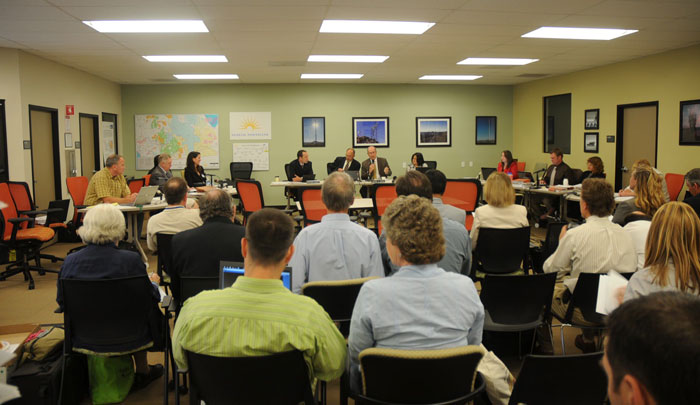^May 2010 California Energy Commission evidentiary hearing in El Centro.
May/July 2010 Hearings and Site Visit
El Centro, Imperial County, California - by Laura Cunningham - The California Energy Commission held evidentiary hearings spaced across May and July to take in testimony on the "Solar 2" Imperial Valley Solar Project consisting of 30,000 Stirling dishes on Bureau of Land Management Colorado Desert habitat. Two Commissioners came to El Centro in May to hear the case, along with a slew of lawyers and expert witnesses for both sides (the applicant Tessera, and various groups and individuals opposing the project). In July the hearings were held in Sacramento at CEC headquarters due to California's enduring budget crisis.
Surprise Project Changes
Tessera introduced a whole new set of project changes in a document, that surprised everyone, at the July 26 hearing day. This has been a problem with many large-scale solar applications, they are a moving target.
Imperial Valley Solar Project Changes
Major Project Changes to Reduce Environmental Impacts and/or Respond to Agency Concerns:
1. Reduction of Project from 900 MW to 750 MW:
The original project envisioned would have included the installation of solar generating facilities capable of generating up to 900 megawatts (MW) of electricity on approximately 7,650 acres of land. Prior to filing the AFC in June 2008, Applicant recognized that development in the eastern portion of the original proposed site would result in significant and unavoidable impacts to sensitive environmental resources. The project was therefore redesigned by the Applicant to avoid these impacts, resulting in a reduction of the developable area to 6,571 acres with the capacity of generating 750 MW of electricity.
2. Avoidance of Impacts to Waters of the United States, and related impacts to biological resources:
Applicant has worked with the Army Corps of Engineers to reduce impacts to Waters of the United States. The Corps is only authorized to approve the Least Environmentally Damaging Practicable Alternative (LEDPA). As proposed, the project would have permanently impacted 177 acres of waters of the United States. As modified, the proposed project reduces permanent impacts to WUS to 38.2 acres, with 14 acres of temporary impacts. The Corps has preliminarily accepted the modifications to the project as the LEDPA. The modifications avoid impacts to the highest flow dry washes on the site, and allows for the generation of approximately 709 MW while significantly reducing impacts to aquatic resources. The modified project avoids the entirety of washes I, K, and C and avoids all of washes E and G southwest of the transmission line corridor, as well as providing a 200 foot wide avoidance corridor in washes E and G northeast of the transmission line corridor. Avoidance of wash C also allows for the preservation of the one existing potential flat tailed horned lizard movement corridor on the site.
The primary avoidance and minimization measures include the following:
a. Reduced total generating capacity from 750 MW to 709 MW eliminating the entire eastern portion from the current project boundary to Dunaway Road which includes the downstream portions of streams E and G.
b. Reduced the number of the east-west roads to minimize the number of roads in washes and the number of wash crossings.
c. The waterline that extends to the SWWTF was shifted and co-located beneath a site arterial and maintenance roads to reduce temporary impacts to WUS to 0.0 acres.
d. The complete avoidance of ephemeral streams I, K, and C and the avoidance of the upper reaches of ephemeral streams E and G. This removed 1,163 SunCatchers from WUS and reduced permanent impacts from 177.4 acres to 39.1 acres.
e. Reducing the width of SunCatcher maintenance roads from 15 feet to 10 feet which is the narrowest road width allowed by industry standards.
f. The removal of spur roads to individual SunCatchers from the maintenance road that runs down the middle of the two roads of SunCatchers. This increases the temporary disturbance for the construction of the SunCatchers by the use of a temporary 50-foot road that includes the 2-foot wide trench for the installation of an underground utility line and hydrogen pipeline, but decreases the permanent impacts to WUS substantially.
3. Avoidance of Cultural Resources on the Project Site:
In addition to the reduction of the project from 900 MW to 750 MW before the AFC was filed, and the associated acreage reduction, Applicant has agreed to the creation of Environmentally Sensitive Areas to avoid cultural resources. The applicant has agreed to avoid areas defined as High Environmentally Sensitive Areas (HESAs) with a minimum buffer of 100-feet. Most HESAs have a buffer beyond 100-feet. For all other identified Environmentally Sensitive Areas (ESAs) the Applicant has agreed to a minimum buffer of 50-feet. Many ESAs have a buffer beyond 50-feet. It should be noted that ESAs being avoided currently are those areas identified by the Applicant. The BLM is still in process evaluating these HESAs and ESAs. If additional HESAs or ESAs arise through the consultation process or through agency review these same avoidance buffers will be implemented, where practicable. It should be noted that no ground-disturbance shall occur without BLM approval.
Other Significant Changes
1. Modification of Water Supply from IID Water to Treated Wastewater:
The original AFC filing stated that the Imperial Irrigation District (IID) would provide water to the Imperial Valley Solar Project. In June 2009, after extensive research of five water supply options, the Applicant filed a Supplement to the AFC proposing the use and conveyance of water from the Seeley Waste Water Treatment Facility (SWWTF) as the Project’s primary water source. The SWWTF is operated by the Seeley County Water District (SCWD) and is designed to produce secondary treated water at the rate of 200,000 gallons per day (gpd) (139 gpm or 224 AFY).
The applicant would finance an upgrade to the existing facility to allow it to meet Title 22 water quality standards and would fund the training of operators for the new facility. These upgrades are also necessary for SWWTF to comply with its existing NPDES permit and avoid future violations of its permit. The SCWD would provide as much treated effluent water as needed to the proposed IVSP. The current influent flow rate is approximately 150,000 gpd, or 168 AFY. Improvements to the treatment facility will provide the Title 22 effluent capacity of 250,000 gpd (current plant capacity). It is anticipated that IVS will need less than 1/3 of the treated effluent during construction and approximately 1/5 of the treated effluent during operation (assuming current production rates). Any surplus water not needed by the IVSP, will be controlled by SCWD and may be discharged into the New River or used for other reclaimed water uses such as irrigation.
Because of delays in the environmental review for the SWWTF upgrades, the applicant proposed in May 2010 to use the Dan Boyer Water Company (DBWC) well in Ocotillo as the project water supply if the SWWTF water supply is not available at the start of construction. The DBWC operates State well #16S/9E-36G4 with a current permitted pumping rate of 40 AFY. Tessera Solar has negotiated a purchase agreement with the DBWC.
2. Hydrogen System:
The original AFC filing described a distributed hydrogen system in which hydrogen would be stored in k-bottles and provided by an offsite supplier (Table 1). In the June 2009 Supplement to the AFC, the Project was updated to include a centralized hydrogen gas supply, storage and distribution system. The system included onsite generation of hydrogen through electrolysis by one hydrogen generator and the storage of that hydrogen in a steel storage tank. Underground piping would deliver hydrogen to 87 individual compressor groups, each supplying 30 storage tanks and each of these tanks supplying hydrogen to 12 SunCatchers (Table 1). This hydrogen system was the one analyzed in the SA/DEIS.
The details of the centralized hydrogen system have evolved over time. The amount of hydrogen stored for each SunCatcher will be increased from 3.4 to 11 standard cubic feet (scf) which would accommodate PCU’s operation. In order to support this increased hydrogen storage at each SunCatcher, the high pressure supply tanks and low pressure dump tanks at each compressor group would accommodate 29,333 scf and 9,900 scf, respectively. In the June 2009 Supplement to the AFC, each high pressure supply tank was anticipated to be 648 scf and each low pressure dump tank was also reported to be 648 scf (Table 1). Overall, these changes to the centralized hydrogen system would result in an increase in the hydrogen stored onsite from 1,070 pounds to 28,400 pounds.
3. Construction Power:
June 2008: The original AFC filing stated that IID would provide electricity to the Imperial Valley Solar Project during construction.
July 2010: On June 16, 2010, IID sent the CEC an email that discussed the inability to adequately serve the project with construction power without additions to their grid. If IID were to make these grid changes, it would take additional time such that construction power would not be available when required.
To obtain the necessary construction power, the project will purchase or lease up to six 230kV diesel generators, depending on the peak construction need. The generators will be EPA Tier 4 generators and will meet local air district requirements. These generators may be available as early as September/October of 2010. In the unlikely event that Tier 4 generators are not available when needed, the Applicant will use a quantity of Tier 3 generators for limited hours, such that their emissions will not exceed federal or state conformity thresholds.
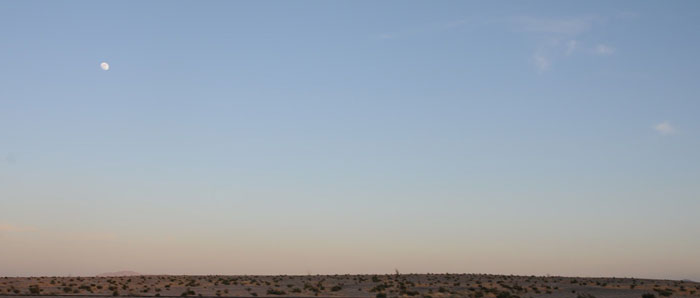
^Moonrise over the project site.
Groundwater Concerns
Much time at the hearings was spent on water. Tessera wants 39.5 acre-feet/year of a local private well, the Don Boyer Water Company well, which produces 40 afy. Mr. Boyer was called to the phone to testify, and he assured everyone he only supplies water to about three permanent residents and a dozen seasonal people that come with jugs, to the amount of a third acre-foot. Tessera wants 51 afy if they do a work week of 7 days for construction, 60% of which would be for dust control. If they did a 5-day work week they would want only 35 afy. Tessera needs to use the Boyer well until the Seeley wastewater treatment upgrade is done, which they are confident will happen in 2011. A pipeline would be constructed to the project site. For operations the Imperial Valley Solar Project would require 33 afy.
Total disagreement on impacts to groundwater was evident, Tessera saying there will be no significant impacts. California Energy Commission staff testified that there will be significant unmitigable impacts to groundwater by pumping, and want Tessera to pay Boyer to not give water out after the project finished using his water.
Water issues were not resolved. It was determined that 96% of the project is in the Imperial groundwater basin, and only 4% in the Ocotillo/Coyote Wells sole source aquifer, where the Boyer well is, so there was a question of exporting water out of the Ocotillo basin -- exported water will have no chance of infiltrating back into the aquifer.
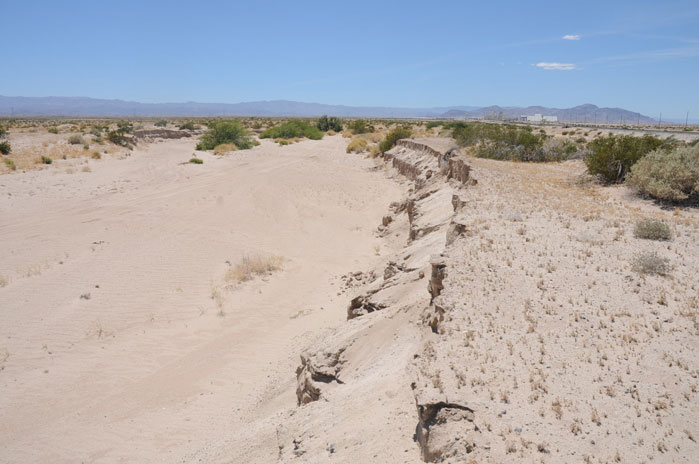
^Very large wash exiting the project site to the northeast. Plaster City gypsum plant is in the distance. The Army Corps of Engineers is requesting (intelligently) that Tessera not place SunCatchers in these washes.
Soils and Surface Waters
Tessera proposes to put SunCatchers in washes. Half of primary washes would be impacted, and all secondary washes. They brought in their hydrologist Dr. Howard Chang to explain how sediment transport would not be a problem in washes, and scour at SunCatcher pedestal bases would be minimal. California Unions for Reliable Energy brought in a hydrologist, Dr. Christopher Bowles, to refute this, saying how old one-dimensional sediment transport models were being used by the applicant, and newer more powerful two-dimensional models could show how scour would swirl around hundreds of SunCatchers. High-intensity short-duration summer monsoon storms were being underestimated, and a lot of scour and sediment transport could occur. Peak magnitude of flows were underestimated by the applicant, as well as "flashiness" - how fast a flood rises and falls. He quoted Army Corp of Engineers saying sediment is transported completely through the project site, and over time erosion could make sediments reach the Salton Sea. Cryptobiotic crust and desert pavement are important in rainfall infiltration, and when compacted by construction, more runoff will happen.
The Corp is now recommending that desert projects follow the Arid California Rapid Assessment Methodology (Draft 2010):
--channels are unpredictable, and are highly susceptible to widening and evulsion. 10-18-year high-intensity storms tend to move channels. SunCatchers in channels will exacerbate this.
--discontinuous ephemeral streams will alternate with erosional and aggradational phases. The system is in flux and is highly dynamic. In this area washes are often braided, with deep-sediment deposits of sands and gravels. They have low sinuosity. Headwaters are often in badlands.
--most rain here falls in the winter and is low-intensity, but 65% of July-September run-off is in the form of intense summer monsoon storms with high flow and short duration. Hydrographs in summer rise rapidly.
--fresh splays of coarse sediment originate by transport from south of Interstate 8. Flooding can deposit sediments into the site, and typically may exit to the north and northeast. So sediment is passing through the site.
--perturbation of natural sediment transport could result in headcutting.
--the condition of the watershed has a big influence on these channels.
Depending on how dirt roads are graded, they could act as water conveyance channels for large summer storms, leading to incision, erosion, degradation, and increased sediment transport.
Any analysis should bracket a range for climate change potential. Dr. Bowles said the applicant's analysis was highly simplified, and did not measure the extent of desert pavement and biological soil crusts -- loss or compaction of these soil types would lead to increased run-off.
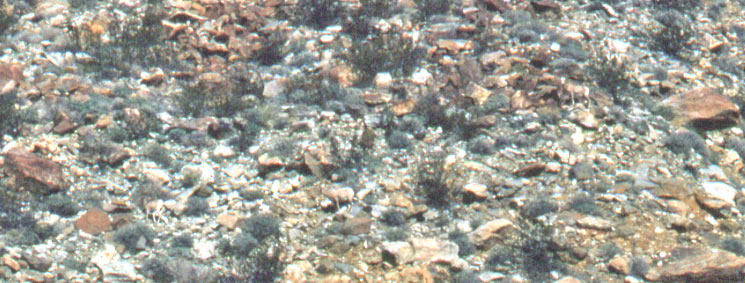
^Peninsular bighorn sheep dot a stony slope in Anza-Borrego Desert State Park.
Biological Resources
Special page on Flat-tailed Horned Lizard (Phrynosoma mcallii) coming.
Peninsular Bighorn Sheep (Ovis canadensis nelsoni Distinct Population Segment) - This fully protected Federally Endangered, State Threatened subspecies was seen on the project site foraging in March 2009 (five ewes and juveniles). The applicant claims this was a fluke, and that the herd might have been accidentally chased onto the site by off-roaders. A resident of the region also saw a herd of sheep in May 2010 (while driving to the hearing) from Interstate 8 about five miles to the west of the project site. Designated Essential habitat for the species lies about six miles away.
The Energy Commission agreed with California Department of Fish and Game that the washes of the project site would be foraging habitat for sheep on occasion, and asked that the applicant mitigate by enhancing Carrizo Creek in Anza-Borrego Desert State Park by removing tamarisk. This creek was apparently historically used by bighorn.
Bighorn sheep expert Dr. Vern Bleich, (who I have worked with at California Department of Fish and Game in the 1990s), testified for CURE that impacts to the sheep were not well addressed. He discussed loss of movement corridors, low-lying foraging habitat, and a failure to analyze the cumulative impacts of the many other large projects planned for the area. In spring, ewes in late gestation forage can have a profound effect on females the following year. In the Colorado Desert, washes can harbor critical nutrients for sheep.
Bleich said the applicant should have done protocol surveys to analyze tracks and sign, to be able to quantify the use of habitat types, amount of time spent in the area, the direction of travel, and even collect fecal material to extract DNA.
He disagreed with Mock, who downplayed the importance of wash habitat for the sheep. Bleich said there are no studies demonstrating a minimum amount of biomass needed to qualify as foraging habitat. The figure of 28% used by the applicant as vegetation cover in washes on the project site, is a tremendous amount of cover in the Sonoran Desert, according to Bleich. If sheep were present on the site, it has suitable habitat.
Interim movements across lowlands may not happen every year, but are important for gene flow and colonization of vacant habitat. This kind of movement is not regular and not predictable, and is very infrequent. But it is very important to metapopulation function. Fragmented species depend on this form of connectivity, that the project site provides.
In addition, this type of movement is very difficult to detect, explained Bleich. Telemetry data is largely absent for this area. There are very few telemetered animals nearby, and most of those are fitted with VHF radios that a biologist must locate from a plane or the ground, usually on a weekly round. Only in the last year have GPS collars been used, giving a continuous location. So the probability of detecting animals using the infrequent telemetry data collection is very low.
One of his greatest concerns as a wildlife biologist, said Bleich, as the development of interim corridors, and acquiring this type of connectivity habitat to preserve it.
Desert Kit Foxes (Vulpes macrotis) were found on the project site, and potential Badger (Taxidea taxus) burrows as well.
Burrowing Owls (Athene cunicularia) on the off-site transmission line.
Golden Eagles (Aquila chrysaetos) could use the project site to hunt Black-tailed jackrabbits. BLM clarified that Golden eagles do indeed nest in the Coyote Mountains 7 miles to the west. All eagles ar protected from "take" including disturbing nests, by the Bald and Golden Eagle Protection Act.
Several rare plants were found on the site: Brown turbines (Malperia tenuis) is an annual found just north of Highway 8, with California Natural Diversity Database Rank 1, meaning less than 1,000 plants exist. It has a California Native Plant Society List 2. Harwood's milkvetch (Astragalus insularis var. harwoodii) was found in the southwest corner of the project site in late spring 2010 surveys. It is a Rank 2, with 1,000 to 3,000 individuals known, and CNPS List 2. Wiggin's croton (Croton wigginsii) is a perennial shrub, listed by the state as rare, and by BLM as a sensitive species. The Energy Commission claims it can be avoided.
CEC, BLM, and Fish and Game are requiring Tessera to do late summer and fall 2010 plant surveys to try to catch species that only bloom after warm monsoonal rains. Mitigation for rare plants would be on-site avoidance and off-site habitat acquisition and enhancement.
Reliability of SunCatchers
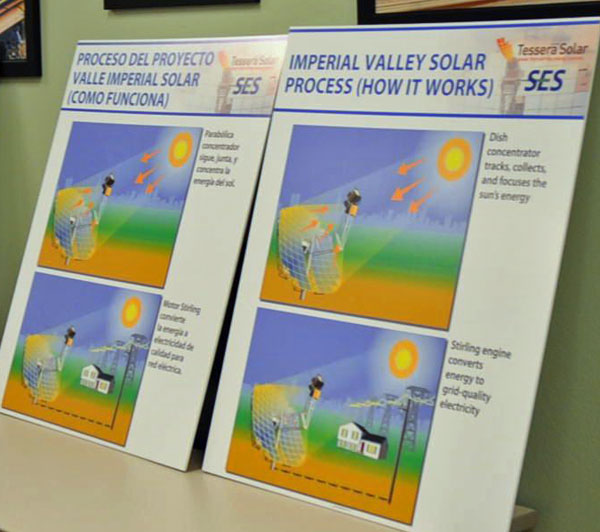
^Posters at the hearing in El Centro.
Tessera has an operating test facility at Maricopa, near Phoenix, Arizona, that feeds electricity to the grid. There are 60 SunCatchers at the facility. Tessera gave testimony at the hearings that availability was 96.1% here (this number is down from 99% in former statements). The availability factor of a power plant is the amount of time that it is able to produce electricity over a certain period, divided by the amount of the time in the period. On-sun dish hours are said to be 74,922 hours from March through July 21.
The Maricopa facility has 7 technicians total, with 4 on shift and 3 on staff.
33 acre-feet per year of water would be used, mostly for mirror washing on the dishes, to keep reflectivity high. Soiling of the mirrors by dust and dirt would degrade reflectivity and result in a loss of energy. Based on tests at the Sandia National Laboratories (New Mexico), Tessera predicted that the dishes would need to be washed 9 tines a year. There was apparently a delicate balance between the number of washes and recovering the labor cost to wash. Pressure washes could remove many types of soils, claimed Tessera, so location of the plant should not matter. They based soiling rates on an aggregate of wash data from Sandia, Maricopa, and heliostat data.
At Maricopa, two spare Power Conversion Units (PUCs) are kept for each SunCatcher in case it fails. Tessera said most PUCs have remained unswapped since the start. Stirling Energy Systems gives a warranty to Tessera for the first few years of operation, and provides parts.
Another reliability issue was the need to protect the engine from a sudden burst of heat due to a passing cloud turning the sun "off" then back "on."
Each group of 360 SunCatchers would be fed hydrogen through pipes from a centralized compressor. The initial fill was increased from 3.4 cubic feet to 11 cubic feet hydrogen so that a higher pressure was present at the start of the day, thus increasing efficiency of the engine through the day. Each engine produces 25 kilowatts. This feed from pipes is needed because hydrogen, being the smallest molecule, leaks out of the machinery at a rate of 600 cubic feet/year. This increase in pressurization was thought be Tessera to help increase the reliability. Along with this, the design of the pressure tanks changed: the low-pressure supply tank increased by a factor of 15, individual surge tanks increased by a factor of 22, and high-pressure tanks were 45 times larger.
At Maricopa there is 7,000 feet of continuous solid tube piping (1.5 inch) in the ground, with no fittings to reduce hydrogen leakage. Minor leaks do happen at the manifolds, however. Most hydrogen leaks out of the PUCs, mostly during the day, but some at night.
In the sun there is a rapid rise in engine temperature to 720 degrees Celsius, and then to 1300 degrees C across the eye opening of the Stirling engine; cool hydrogen is introduced into this eye and as it heats up, moving the piston. The heater head discharges the hydrogen and allows new cool hydrogen to enter. The engine is not driven by a pressure change, but by a temperature change. In trying to keep this temperature gradient, however, engineers found that they needed to flush more hydrogen through the system than originally thought.
Safety
This leads into safety of the project. Hydrogen can be dangerous if not handled correctly. The revised amount of hydrogen that would be on-site is now 5 million cubic feet (as of May 2010).
"Release scenarios" were brought up, where hydrogen release accidents were analyzed into a pie chart: equipment failure accounted for most accidents (47%), then human error, design flaws, and "other."
The exact nature of a "1 psi overpressure" was teased out. The applicant, after discussing how this was an EPA regulatory guidance language for an event capable of "partial demolition of a house" within 0.3 mile. If an event happened to a single SunCatcher, this would not go beyond 53 feet. Even a worst-case scenario of an entire grouping of SunCatcher assembly would not affect an area beyond 300 feet.
An on-site 9 x 30-foot cylindrical hydrogen holding tank at 600 psi would have no larger danger than similar tanks in urban areas, yet safety needs to be considered. If there was a hydrogen release and a spark, then in an "ignition scenario" heat and overpressurization would cause flames, and the tank would disintegrate. There would be no projectiles, stated the Maricopa engineer. "Most" of the worst-case scenario remains on-site, he said.
Alternatives
In a supplemental version of the CEC's Staff Assessment, the Energy Commission favored a reduced-acreage alternative, "Drainage Alternative 1," that would be 632 MW. Tessera said this was impracticable, explaining its "economies of scale" and "dollar-per-kilowatt basis."
The applicant needed a permit from Army Corps of Engineers (ACE), which has jurisdiction over the larger ephemeral washes on the project site under the Environmental Protection Agency's Clean Water Act. ACE preferred to have no SunCatchers in these washes, but Tessera argued that this reduced-megawatt alternative would be very difficult for them. They said it was much more cost-effective to have generator groups in linear, square configurations. If these had to be modified into irregular shapes to avoid sensitive areas and washes, there would need to be more hydrogen pipes and more ground disturbance. Non-standard generator groups would require pipes and cables to be cut and measured on site, instead of being pre-cut in the factory, and shipped in rectangular configurations.
The cost-per-kilowatt was tied to the Power Purchase Agreement with the utility, and Tessera said it must fix the cost below that from an investment point of view, to attract equity. Their cost now was $3,000/kW (some solar technologies can be as high as $4,000/kW; natural gas-fired plants are typically $1,000/kW).
Tessera gave in to a slightly lower figure of 709 MW as acceptable, down from 750 MW. The CEC attorney pointed out that earlier in the year Tessera stated that 750 MW was their absolute minimum, now 709 was "acceptable." Currently, Tessera has a PPA for 300 MW with SDG&E, but felt that other PPAs would follow for the remaining MW.
California Native Plant Society said they would like to see an agricultural land alternative, tied to restoration of the Salton Sea. Imperial County agricultural land transpires 71 inches of water per year.
Land Use, Private Property Rights, Visual Impact
Several private parcels are within the project site, and the county requires a 30-foot setback from these parcels. Tessera at the May hearings requested an override of county laws on this topic.
One land-owner tried in vain at the May hearings to seek resolution as to what would happen to his 160-acre parcel that would become completely enclosed by the project. It lay right in the middle of the vast SunCatcher array. "What can I do with this land?" The visual impact would be huge, he asked in a frustrated tone, "Will I be able to see the mountains from my land?" No one answered him. The SunCatchers are 40 feet tall and would surround his property on all four sides. The landowner also brought up the noise of all the Stirling engine pistons hammering away during the day -- "Do you think anyone is going to be able to live there?" The Energy Commission hearing officer finally told the man that this was not about land values.
Glare from the 30,000 SunCatchers might be a safety issue with traffic on adjacent Interstate highway 8. CEC wants a 500-foot setback, but Tessera argued for 300 feet. CEC compromised that 360 feet might be acceptable. At Maricopa a problem might exist with a bright spot of reflected sunlight on the top of the dish.
The National Park Service had issues with the views around the Juan de Bautista Anza National Historic Trail, which crosses the proposed project site and has campsites and areas where visitors are directed to view, such as nearby geoglyphs. CEC mentioned the possible mitigation of moving this trail corridor south into the Yuha Area of Critical Environmental Concern, out of the project viewshed (this would impact the resident population of Flat-tailed horned lizards). The Park Service also has concerns with night-lighting of the industrial power plant. The trail corridor is presently a designated trail on BLM land.
Financing Deadlines
Project Cost: $2,000,000,000
ARRA Grant - 30%: $600,000,000
Owner Equity - 20%: $400,000,000
Federal Financing - 50%: $1,000,000,000
Tessera said the the American Recovery and Reinvestment Act 30% grant for construction is a crucial part of their financing plan, and this deadline was December 31, 2010. A requirement of the grant is to have 5% expenditure of the overall project in place. Tessera said it was "highly dependent" on this grant. Investors were always in flux based on the current bank market and equity market.
Tessera also applied for a hefty Department of Energy loan guarantee.
A Power Purchase Agreement with San Diego Gas and Electric requires 9 MW to be online by July 2011. A transmission interconnection was required by June 30, 2011. An upgrade line would go through Flat-tailed lizard habitat in the Yuha ACEC, and Tessera is banking on the construction of the new 500 kV Sunrise Powerlink to be able to ship its electricity to coastal california cities, a project that in itself is currently mired in controversy and litigation.
Cultural Resources
See >>here.
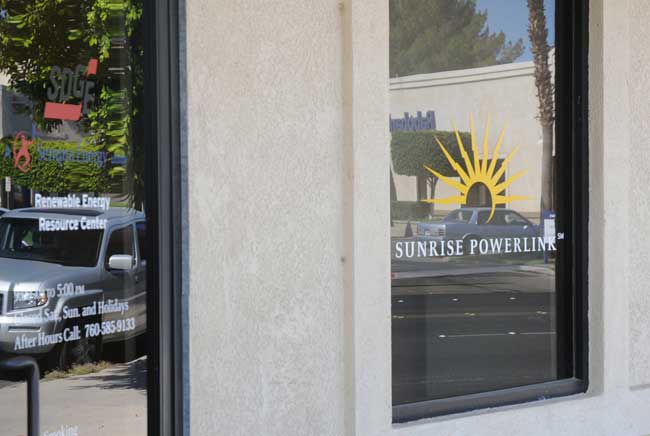
^The May hearings were held in the Renewable Energy Resource Center owned by San Diego Gas and Electric in El Centro, and their support for the unpopular new transmission line, the Sunrise Powerlink that would stretch from solar and wind projects like Imperial Solar to San Diego, was hard to miss. This did not seem to be the most neutral place to hold hearings.
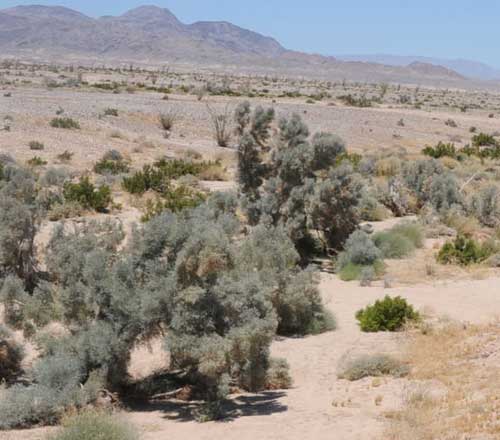
^Tessera claimed there were no Phreatophytes on the project site, but we photographed these Smoke trees (Psorothamnus spinosus) along the southern part of the project, extending well into it along washes.
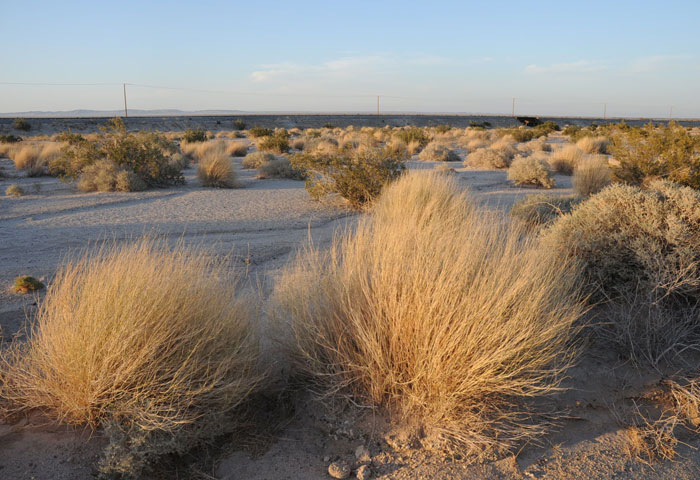
^Beautiful sunset scene of lush Big galleta grass field (Pleuraphis rigida), a rare community type on the Colorado Desert. The railway lies in the background.
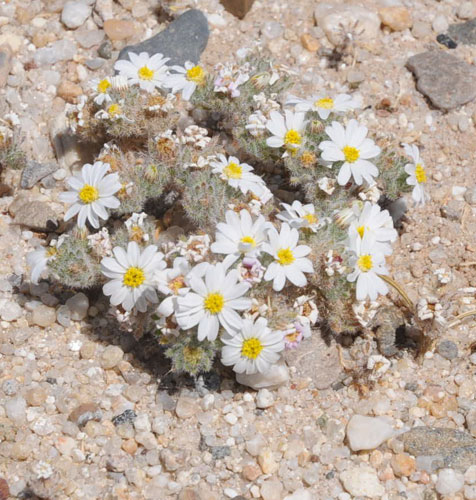
^Mojave desertstar (Monoptilon bellioides).
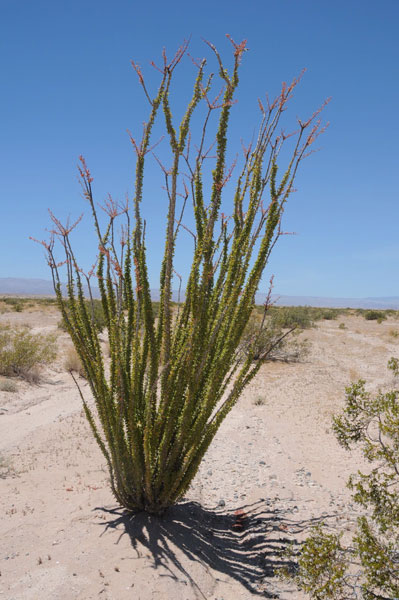
^Ocotillo (Fouquieria splendens) in the western project site, leafed out in May 2010.
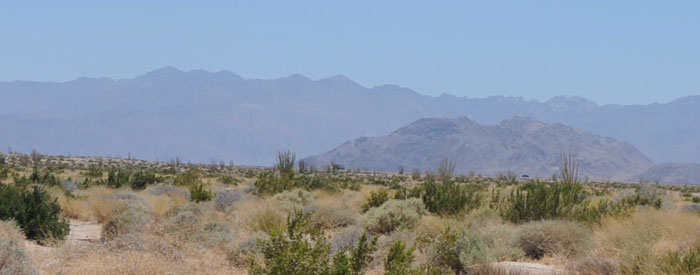
^Western project site area with lush Ocotillos and wash scrub.
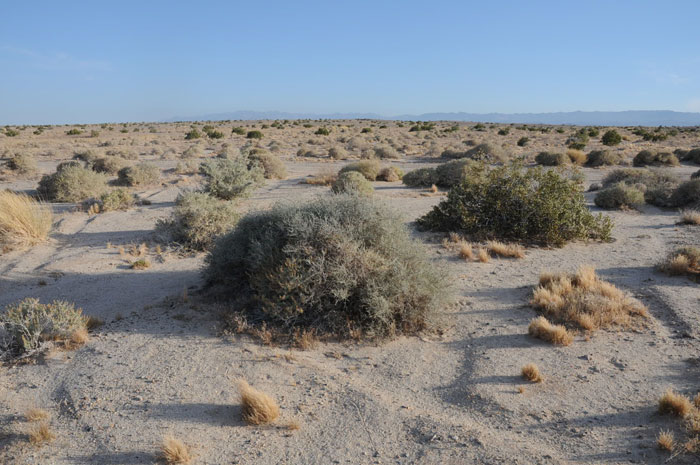
^Central project site with Dye plant bush.
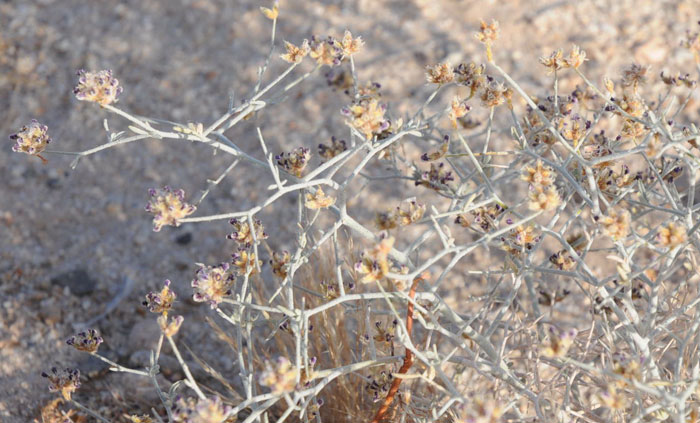
^Dye plant or Smokebush (Psorothamnus emoryi), small violet flowers.
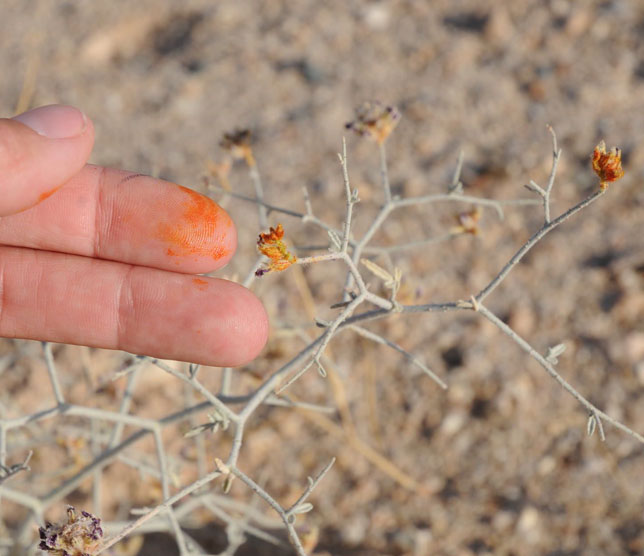
^The flowers of Dye plant stain my fingers bright yellow.
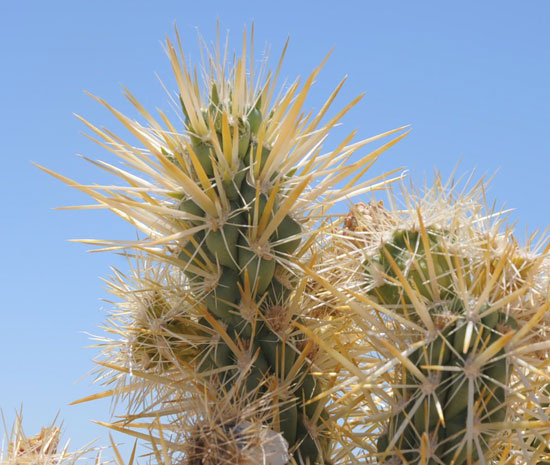
^Golden spines of Silver cholla (Cylindropuntia echinocarpa).
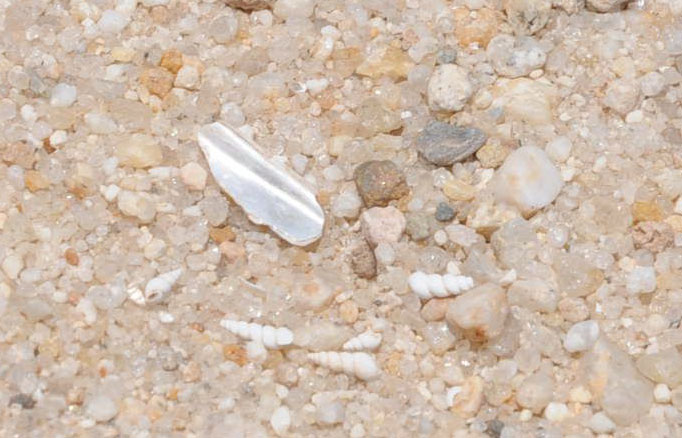
^The project lies across an ancient shoreline, hundreds of years old, of Lake Cahuilla. Small shells litter the sand in places, giving clues as to why the area is so rich archaeologically.
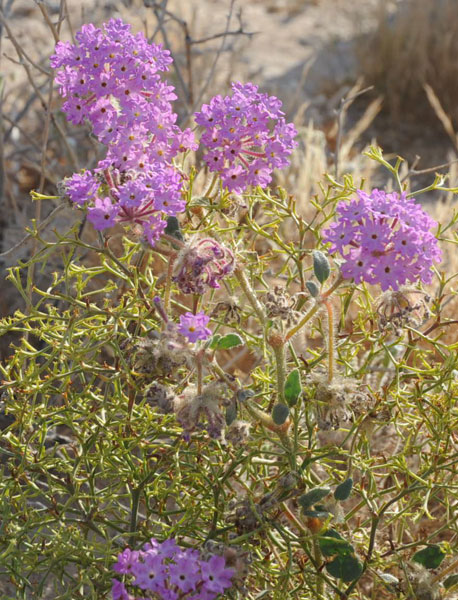
^Desert sand verbena (Abronia villosa).
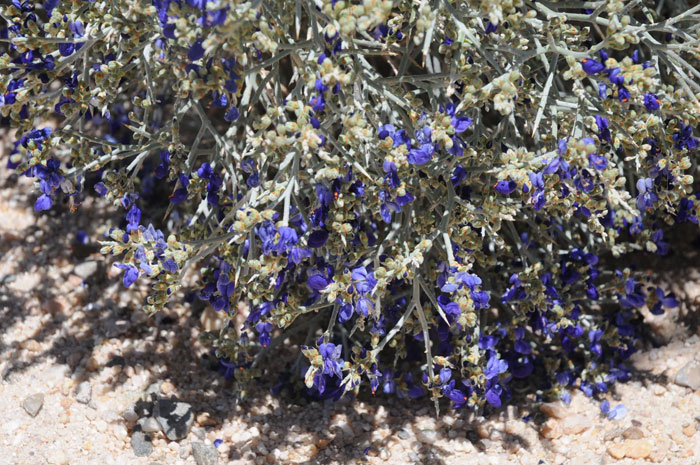
^Smoke tree flowers amaze the senses.
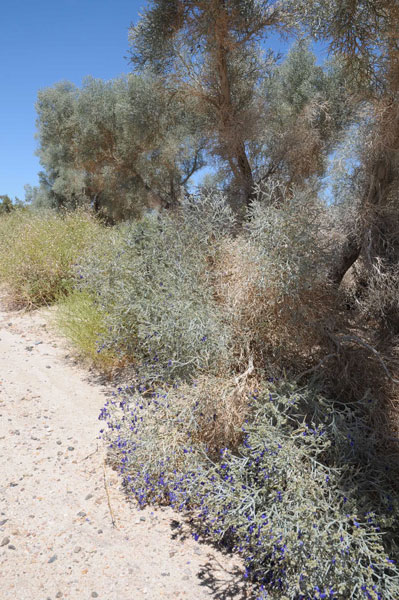
^Smoke tree wash.
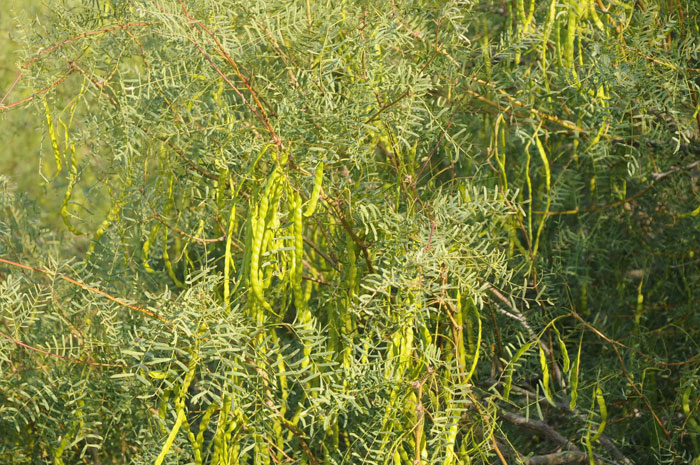
^Honey mesquite (Prosopis glandulosa) pods forming in May 2010.
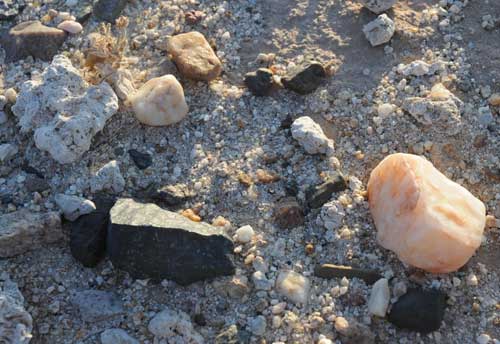
^Desert pavement is common on the project site, and here the rocks are carved into ventifacts, "artifacts of the wind" by high winds.
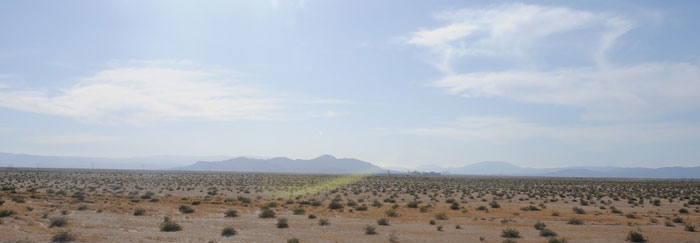
^The project area as seen from the eastern side, across the ancient beach shoreline.
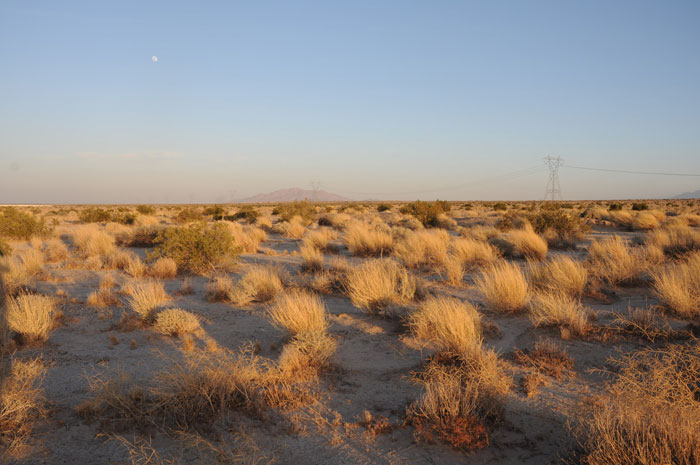
^Moonrise over the galleta grass on the project site, chosen for its proximity to an existing powerline, which is too small to handle the capacity of the full project.
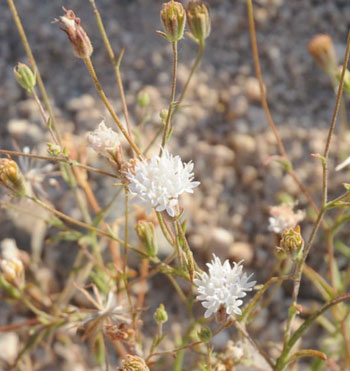
^Desert pincushion (Chaenactis stevioides).
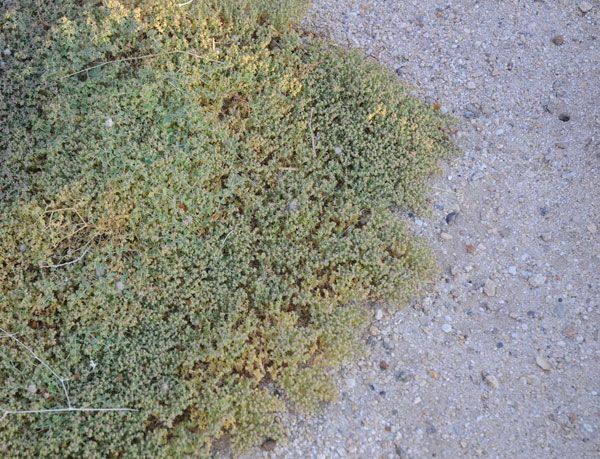
^A peculiar flat mat plant hugs the ground on the project site.
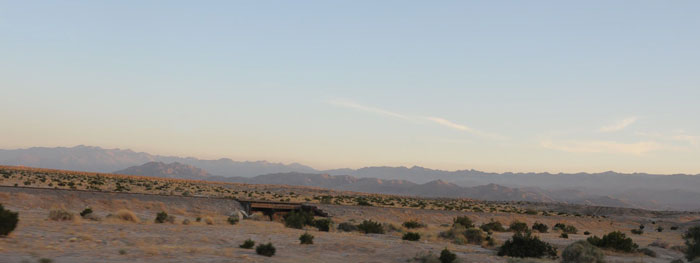
^Sunset hills looking westward from the project area.
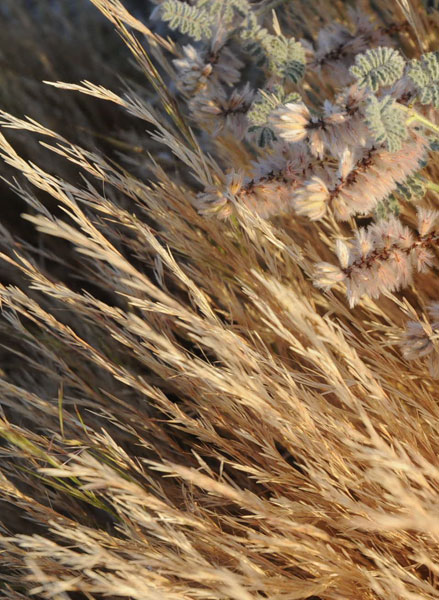
^Downy prairie-clover (Dalea neomexicana) grows with a native annual grass Six-weeks three-awn (Aristida adscensionis).
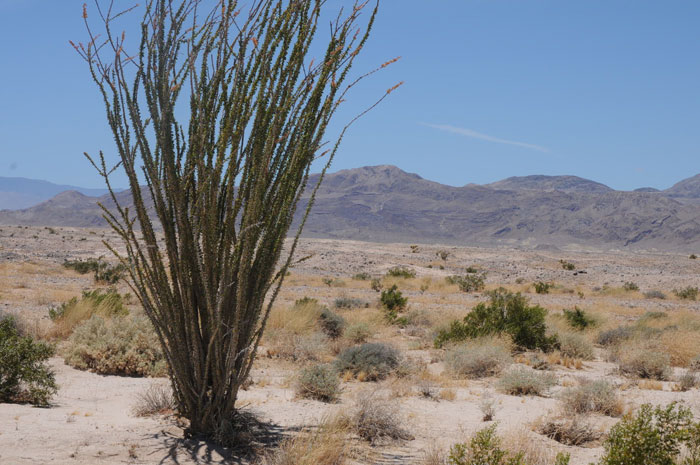
^Ocotillo and wash, western project site.
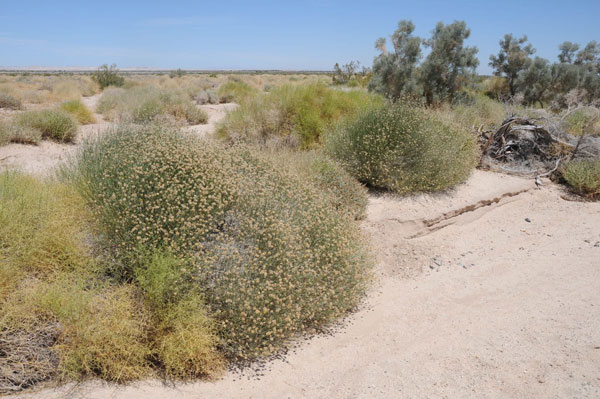
^Wash with Sweetbush (Bebbia juncea), Cheesebush (Salazaria mexicana), and Smoke trees.
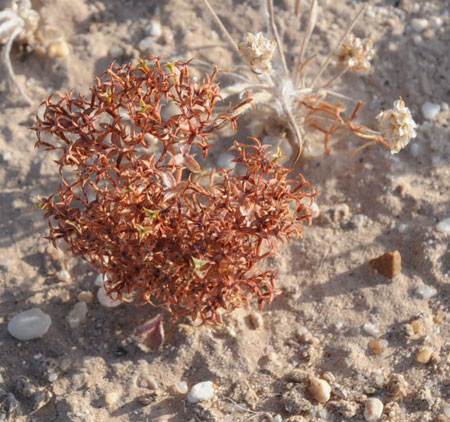
^Chorizanthe (Chorizanthe corrugata).
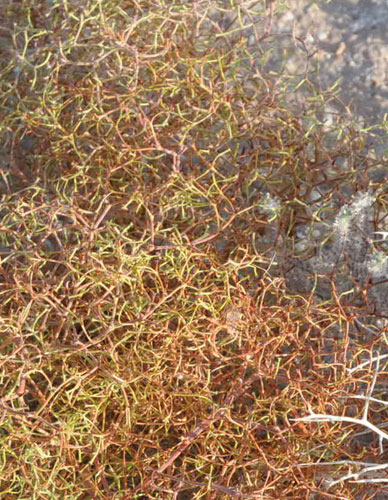
^Another species of Chorizanthe (Chorizanthe bicornu).
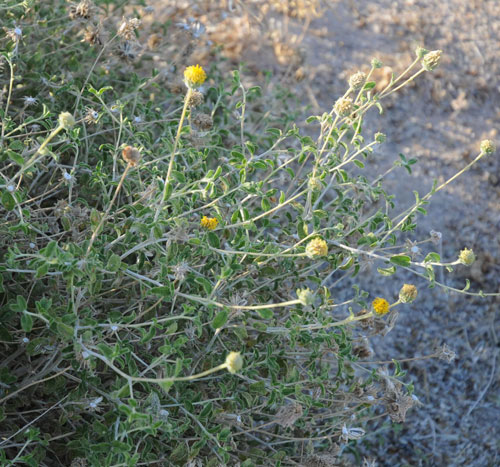
^Brittlebush (Encelia sp.).
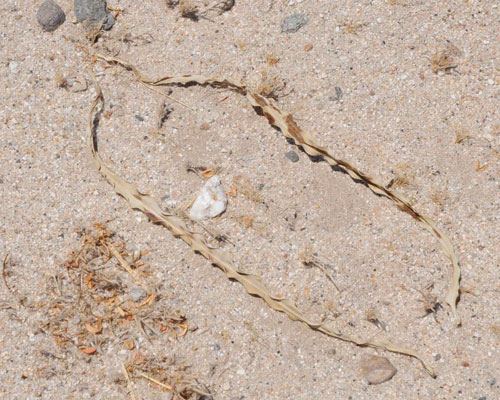
^In May 2010, the dried leaves of Desert lily (Hesperocallis undulata) speak of past blooms, on the project site.
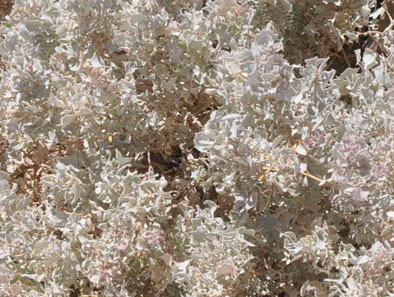
^Desert holly (Atriplex hymenelytra).
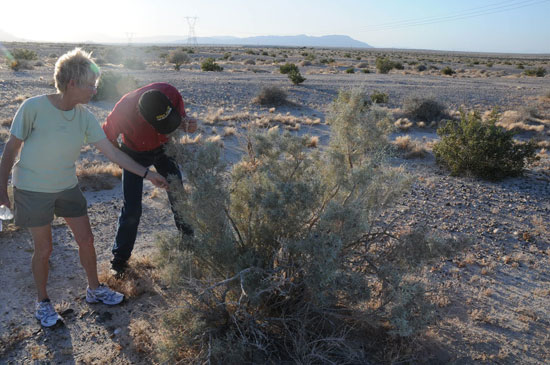
^Desert conservationists examine a Smoke bush on the central part of the project site.
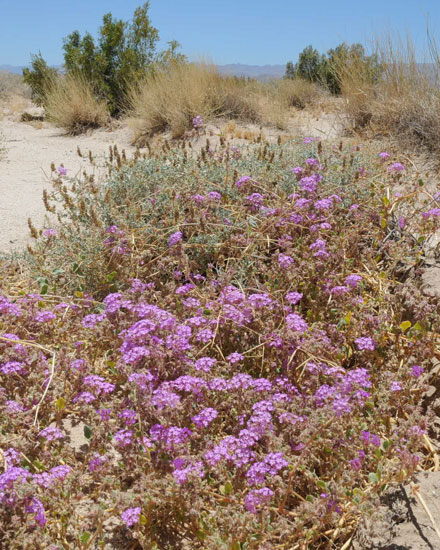
^Sand verbena and Bursage (Ambrosia dumosa).
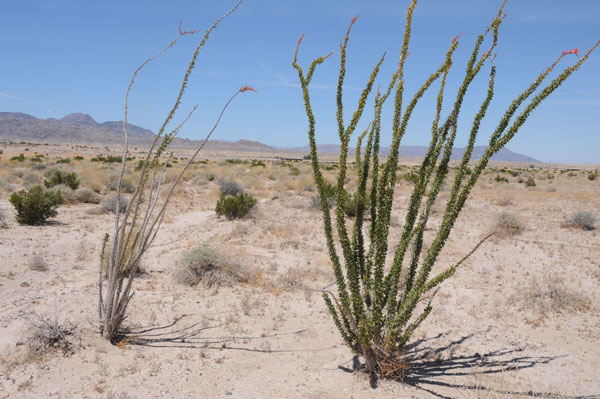
^Ocotillos on the west part.
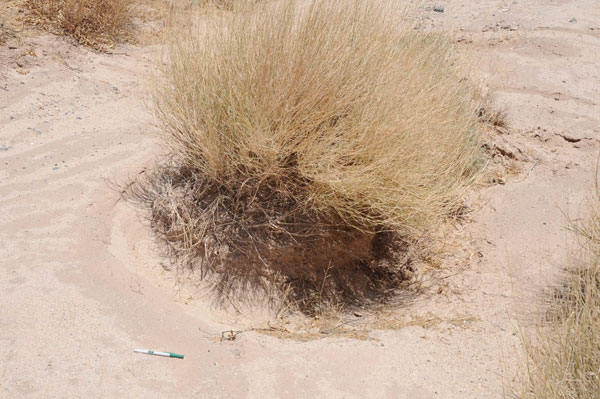
^Wash with scour around the base of a galleta grass bunch. SunCatchers are proposed to be placed in these washes.
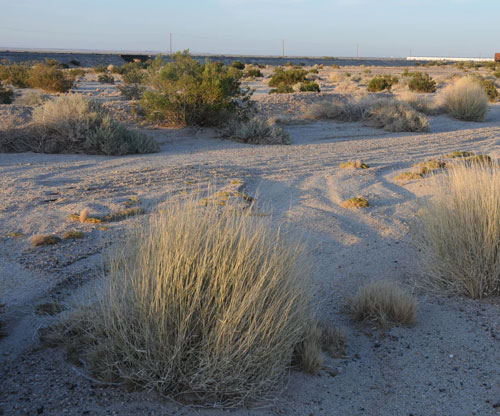
^Sunset galleta grass.
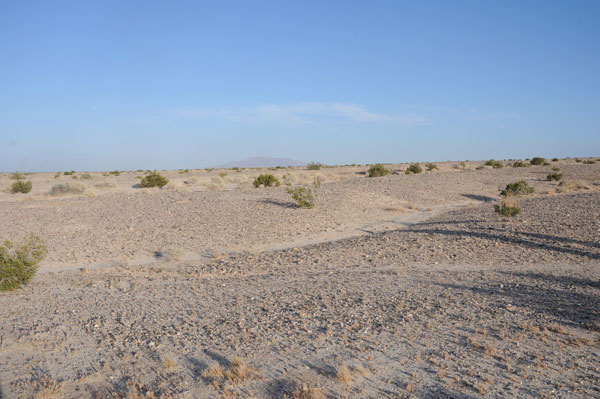
^Desert pavement on the project site is an important arid soil type that stabilizes dust-prone surfaces and allows rainwater to infiltrate into the aquifer.
HOME.....Imperial Valley Solar Updates....April Wildflower Visit.....Stirling Dish
